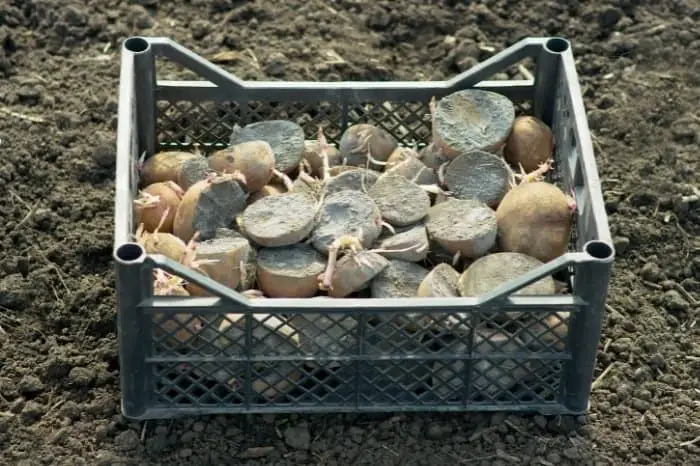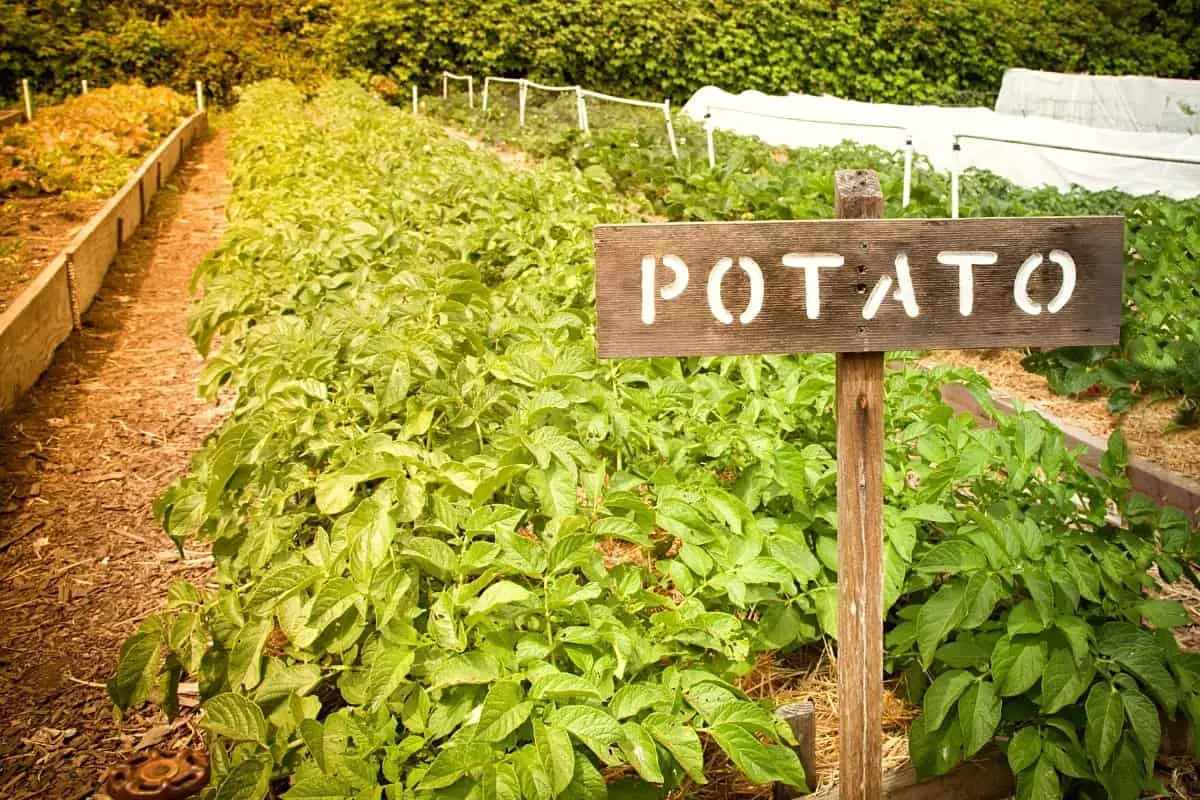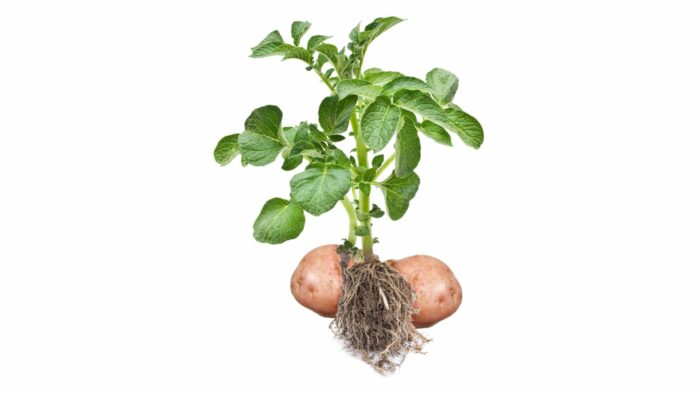Last Updated on March 1, 2023 by Sharon Vanessa
If you want to know how long do potatoes take to grow, then take heed of the following information. Our potato-growing guide will cover the most asked question – how long does it take for potatoes to grow and general tips to cultivate this crop.
Did you know you can grow potatoes in your garden? The advantage of growing your own vegetables is that you can have a full year’s crop that you enjoy without incurring the costs of buying them from the stores.
Potatoes are much-loved vegetables, and they do well across America. You can plant your potatoes early in the spring as soon as the frost is gone out of the soil as it will become easier to work with. Let’s delve into the information below to learn about this favored vegetable harvest.
How Long Does It Take Potatoes to Grow?
To arrest your fears, we will talk about how long it takes to grow your potato crop from seed to harvest.
How long does it take potatoes to grow depends on the variety of the potatoes you seed. This may sound confusing, but we will explain it below. There are 3 main types of potatoes, each having a different maturity time.
-
The Early Varieties have shorter maturity times and are fully grown and ready for harvest in less than 90 days from seeding. These potato types are best for cool regions to help you harvest an early crop. Some early varieties include Red Norland and King Harry, which have purple skin and are resistant to Caribe potato beetles.
-
The Mid-Season Varieties reach their maturity in about 100 days from seeding and are best for planting in warm areas.
-
The Late Variety produces enough potatoes to take you through winter, and they mature in about 110 days. They are ideal for warm areas and store very well for longer periods.
Generally, it takes about 80-110 days for your potatoes to reach maturity. So, how do you know when potatoes are ready to harvest? You can start harvesting your potatoes as soon as you notice the first large enough tubers. You do not have to wait for the potatoes to reach their full size. This is because the small young tubers are tender and tasty too.
Useful Tips to Follow on How to Grow Potatoes
Regardless of what variety you choose to grow, there are a few growing tips you should follow to ensure you get a good harvest.
Get certified tubers
Each potato tuber equals a potato seed! Your potato harvest will grow to form the tubers you plant in the ground. You can use any tuber, yes, but if you want a good harvest, then go for certified varieties. These tubers from a local nursery are ready for planting and will easily sprout. Potatoes sold in the supermarket are treated against sprouting. And even if they sprout and you grow from them, the potatoes will be weaker and prone to diseases.
Pre-sprout your potatoes indoors
If you want your crop to start well, plant pre-sprouted potatoes. To pre-sprout, place the tubers in a warm, well-lit room for about 5 weeks before planting. You will notice sprouts beginning to come out from the tubers after a while. Planting pre-sprouted potatoes gives you the advantage of harvesting at least a month before the standard maturity time.
Potato Grow Bags – Potato Growing Containers Contains
Fertilize your growing potatoes
When seeding your potatoes, fertilize them and do so again when the plants are growing. This gesture will afford you good produce.
Mulch heavily
Potatoes need a lot of moisture to grow well. The best way to keep the moisture levels high is by mulching with a good layer of leaves, straws, or plastic mulch. Also, heap a good amount of soil at their base to cover the growing potatoes. This will protect them from direct sunlight, which has the potential to turn them green if they come into contact with it.
Cover the potatoes as they grow in case of poor weather
If you have already seeded your potatoes and a frost is coming, use an old blanket to cover the seedlings to protect them. Covering protects them from frost, and the stems will continue to grow as soon as you remove the blanket. If you don’t protect your potatoes, they will frost, which will delay their maturity date.
Plant more tubers as soon as you harvest your ready potatoes
If you want more potatoes in the coming seasons, the secret is to plant them immediately after you harvest instead of leaving the spot vacant. The soil in which your potatoes grew is rich in nutrients, and you can easily grow other crops like beans, tomatoes, squash, etc., in it.

How Long Does It Take for Potatoes to Grow After Planting?
So, how long does it take for potatoes to grow after planting? The answer to this question would depend on a few growing essentials and demands that potato plants need to develop after planting. These include the variety of potatoes you are growing and weather conditions in your region. In general, and with the proper implementations, care, and maintenance, you can expect the potato growing season to last around 3 to 4 months after planting. You also have the option to plant early varieties or immature potatoes that would afford you an early harvest.
Listed below are a few additional tips that you should consider when growing potatoes:
1. It is best to plant small pieces of potatoes or mature tubers as it is easier. These are known as seed potatoes and have buds that are already present.
2. Potatoes are hardy plants that are known as cool-season crops. This means that they can endure a little frost during their growing period.
3. Depending on how dormant the planted seed potato is and the temperature of the soil, this sought-after crop may take up to three weeks to sprout. However, if all is well, you may see them sprout as early as ten days after planting.
4. When it comes to growing temperatures, you must keep in mind that tuber planting requires an environment that has ideal highs of 16 to 19 C. To enhance sprout growth, keeping the temperature steady at 18 C would elongate them.
5. The best planting time for potatoes, as noted by several gardeners, is in March, April, and May. Potato harvesting can be expected in the coming three to four months after planting.
How Long Does It Take for Potatoes to Sprout?
Gardeners and growers often want to know how long it takes for potatoes to sprout. If you are growing seed potatoes, you should expect them to sprout in 14 to 28 days or two to four weeks. However, just as I have mentioned above, growing conditions will depend on soil temperature and other essential factors. During this time, proper care and maintenance are vital to aid your potato plants in sprouting.
This would mean cool summer weather with moderate temperatures and well-drained soil conditions. However, keep in mind that potatoes are widely adaptable and can endure even harsh conditions. If your find that your plants are not sprouting as fast, this could be because they have been sowed in soil that is not compatible. The reason their growth is flawed and they are slow to emerge could be because of a lack of moisture, excessive moisture, or extremely cold conditions.
It could also mean that seed potatoes that have been freshly cut and planted are dehydrated, hence the build-up of disease and flawed growth. But, all is not lost as adding apples or onion bulbs around the potato tubers will enhance the sprouting process. This is because apples and onions release beneficial gasses that encourage potato sprouting. The addition of a moist cloth around the tubers will also aid in the sprouting process as it will keep them hydrated.
Can You Grow Potatoes Indoors All Year Round?
So, can you grow potatoes indoors all year round? Potatoes thrive in bright light as it enhances their growth. If you are growing potatoes indoors, then keeping them under grow lights or at a sunny window would prove beneficial. This is because these favorable conditions will all you to grow them healthily all year through. Seeing that these starchy vegetables are a great source of nutrients, you would have no hassle harvesting and storing them for extended periods.
Here’s some handy advice when growing potato plants indoors:
- Ensure that your indoor potato plants are growing in a container that is deep enough to accommodate them.
- Ensure that your plant pot has ample drainage holes to get rid of excess moisture.
- It is best to use well-draining soil when planting potatoes in pots, as it will prevent rot and disease.
- If you place your plant pot at a sunny window, remember to rotate the container when the sun is at its brightest. This will ensure that your potatoes receive an equal amount of sunlight throughout the day.
- Indoor potato plants can be started at any time of the year because they will have enough protection against the elements in a closed environment.
- You should also consider that compared to container-grown potatoes, ground-grown varieties offer a much better yield where weight is concerned.
Conclusion – How Long Do Potatoes Take to Grow
How long it takes to grow potatoes is no longer a mystery to you now. You only have to decide what type to plant and how much. Do not forget you can keep a few tubers from your harvest to plant in your next season.
FAQs
How do I know when my potatoes are ready to harvest?
Potatoes are a cool season crop and require consistent temperatures between 45°F and 70°F (7°C to 21°C). The best time for harvest is early morning, before the sun has risen. This is called “the witching hour” in potato-growing folklore. At this time, the stalks and leaves are fully green, but the tubers are just starting to turn yellow.
Harvesting when the foliage is still green ensures that the potatoes are of the highest quality. In general, potatoes should be stored at 40°F to 50°F (4°C to 10°C) until they are needed. Potatoes can also be stored in a cool, dark place at room temperature. Growing Tips Potatoes can grow in almost any soil type, although they prefer a pH of 6.
What kind of nutritients do potatoes need to grow?
The best soil for growing potatoes is one with high organic matter content, but even a well-fertilized soil can support good potato crops if it has adequate nutrients. Potatoes do not require a large amount of nitrogen, but they will produce more tubers per plant when there is enough available nitrogen.
Should you water potatoes every day?
Potatoes are a starch plant, and as such are very thirsty. They require more than half their weight in water per day to survive.
hey also have a high rate of respiration. These two factors combine to make them an energy-demanding crop. The potato is a low-growing, bushy plant with a spindly stem, which means that the plant takes up a lot of space, and therefore has to be carefully managed.
Can you grow potatoes all year round?
There are a lot of people that believe you can grow potatoes all year round, and for those that believe this, we are here to tell them that it is not possible. Potatoes are a cool season crop and they will die out in the winter if they are not given special treatment. You will be able to grow potatoes in your garden during the summer months but not all year round.
How many potatoes will one plant produce?
Potatoes are grown from seed, but can be propagated by division. Each plant produces up to 25 tubers in the first season. Potatoes are planted in late winter or early spring and left to grow through the summer. If you want to grow a few potatoes for yourself, this is a good way to go. In this case, the potato plants will be growing in a greenhouse, with some light and protection.
One plant produces around 10 potatoes.
It is possible to Start the Potato Seeds Indoors?
It is possible to start the potatoes indoors, but you’ll need to provide some heat to give them a head start. It is not advisable to use a heater for this purpose. You should provide adequate light, and if possible, protect the plants from drafts and cold air.
The seed potatoes can be placed in a container that has holes punched into the bottom. The holes should be large enough to allow the roots to grow out of the container.This is because the potatoes should be kept at a temperature of about 65°F to 70°F, so they can get started.
Caroline is a gardener who loves to get down to the nitty–gritty of gardening. She proudly proclaims herself as a ‘dirt worshipper‘ and can often be found deep in the garden, covered in soil and singing to her plants. As a self–proclaimed ‘plant whisperer‘, Caroline believes that plants need love and attention just like any other living thing, and she loves to give them both. When she‘s not tending to her garden, you can often find her researching the latest gardening trends, or teaching others how to make their gardens thrive




